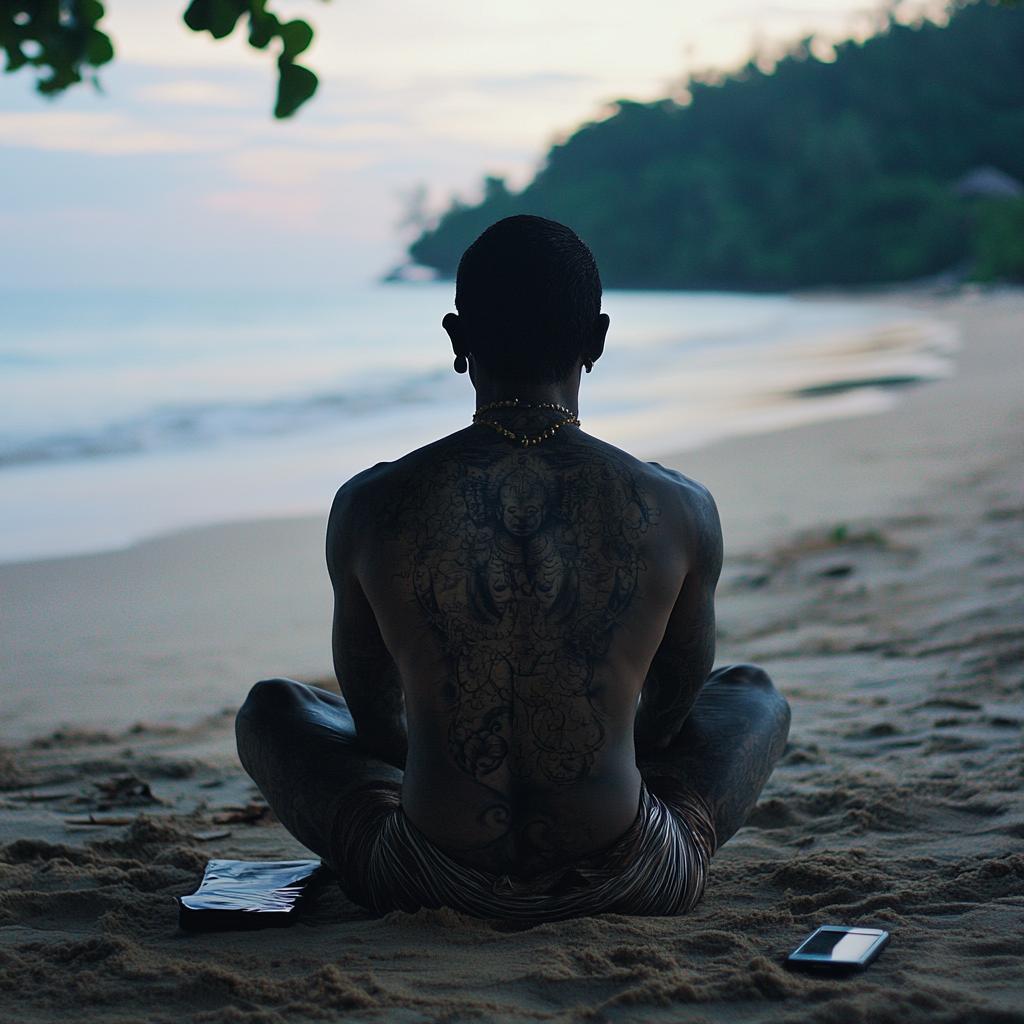In the ever-enigmatic land of Phuket, a recent mystery has gripped the town’s attention, unfolding in the shadows of an abandoned building known as Billion Plaza, nestled in the serene locality of Moo 1, Kathu. On the late afternoon of April 21, the Kathu Police were summoned to unravel a disquieting scene— the discovery of a decomposed body. Accompanied by a forensic expert from Vachira Phuket Hospital and the diligent rescue workers of Kusoldharm Phuket Foundation, the officers embarked on their solemn duty.
The unfortunate soul, identified as a Thai male around the age of 40, was marked by a unique Hanuman tattoo on his back—a clue that might eventually unfold parts of his untold story. However, the enigma only deepened as no identification documents accompanied him, leaving him a nameless figure in the archives of the unknown. Residents, who had grown accustomed to seeing him around, speculated that he was homeless, grappling silently with mental health issues. His abode in the derelict building had been a temporal shelter for about two months.
Intriguingly, as the investigation turned the pages of his recent past, signs of struggle or foul play remained absent. Instead, initial assessments suggested that a chronic illness might have been his silent adversary, drawing him towards an unceremonious demise. His story is now in the hands of the medical team at Vachira Phuket Hospital, who delve deeper to unveil the exact cause of his untimely departure.
Drawing a disconcerting parallel, the beaches of South Pattaya were the setting of another grim tale. On April 5, beneath the gentle morning rays, the lifeless body of a 40-year-old Chinese tourist was discovered face down on the sands of Yin Yom Beach. The sight was enough to jolt even the most serene souls from their holiday reverie. The tourist, ensconced in a simple white T-shirt and jeans, bore injuries on both his forehead and neck, a silent testament to a possibly violent encounter.
The meticulous inspection led by Police Lieutenant Colonel Saijai Khamjulla of the Pattaya City Police Station revealed further telling details. The discovery of a fractured eye socket and the ominous presence of blood hinted at violence. Yet, beside him lay an intact mobile phone, a lone slipper, his passport, and a bank passbook containing 60,000 baht. It was a peculiar mélange of clues, echoing softly the fractured sequence of his last hours, estimated to be between six and 12 prior to being found.
As these two tales of despair unfold against the vibrant backdrop of Thai life, the kaleidoscope of ongoing narratives continues to spin. From earthquake damages in Chiang Mai to king cobras causing commotion in Surat Thani, Thailand remains a land of intricate stories tethered together by its shared breath of life. Casinos of the heart open up, with some tales narrating victories—like a Thai taxi driver who, upon winning the lottery, showered his passengers with generosity.
Such is the tapestry of Thailand, where tales of unforeseen tragedy and unbridled kindness form a poignant panorama. And albeit the shadows loomed larger for these two men, their stories add yet another hue to the rich, unsettling beauty that is, and forever will be, the living story of Thailand.


















Such tragic stories that reflect both the beauty and, unfortunately, the darker side of Thai life. I wonder if these incidents speak to a larger societal issue?
I think it’s more about the neglect of mental health. If the man in Phuket had more support, this might have been avoided.
True, but sometimes people choose to be alone. We shouldn’t assume everyone wants our help.
Phuket and Pattaya are tourist hubs. They attract all sorts of problems, including crime.
That’s a fair point, Mia. High tourist volumes can unfortunately bring unforeseen problems.
Thailand’s handling of such cases might seem too laissez-faire to outsiders, but remember, they have their own ways.
As an anthropologist, these stories remind us of the cultural nuances in dealing with death and tragedy. Are the local authorities doing enough though?
Leslie, it’s probably all wrapped up in bureaucracy. But I agree—they could handle these issues more effectively.
Why was the Chinese tourist’s mobile phone untouched? Seems too convenient for a violent crime.
Could be staged to look like an accident. Criminals sometimes slip up with small details.
I find it strange that despite the dangers, so many tourists still flock to Thailand. The risks seem to grow each year.
Every place has its risks. The allure of Thailand, with its beauty and culture, often outweighs the negatives.
These incidents are reminders of the chaos lurking beneath beautiful facades. Safety should be a bigger discussion in tourism.
It’s sad that these tragedies overshadow the good in these communities, like the generous lottery driver.
Why isn’t international media covering this more? These stories deserve a bigger spotlight.
They prefer covering more sensational news. It’s the modern media landscape—the muddier the better.
Heartbreaking when the stories of people become lantern posts in travel warnings. We should travel aware.
The Hanuman tattoo is such a unique identifier, it might offer more clues to the man’s life and connections.
Let’s not forget about cultural stigma; mental health discussions still face barriers in many Asian societies.
If these areas are dangerous, the tourism board should put out strong advisories.
Liam, tourism is a major revenue. They won’t risk it unless it’s extreme.
Maybe there should be a balance between revenue and ensuring safety.
Thailand is still on my list, but with more caution. Travel seems riskier everywhere these days.
Let’s not forget these stories have multiple layers. Respect the victims by recognizing their complexities.
Too often we oversimplify. Every person’s story impacts their community.